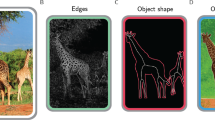Abstract
If features such as color and orientation are processed separately by the brain at early stages1,2, how does the brain subsequently match the correct color and orientation? We found that spatially superposed pairings of orientation with either color or luminance could be reported even for extremely high rates of presentation, which suggests that these features are coded in combination explicitly by early stages, thus eliminating the need for any subsequent binding of information. In contrast, reporting the pairing of spatially separated features required rates an order of magnitude slower, suggesting that perceiving these pairs requires binding at a slow, attentional stage.
This is a preview of subscription content, access via your institution
Access options
Subscribe to this journal
Receive 12 print issues and online access
$209.00 per year
only $17.42 per issue
Buy this article
- Purchase on Springer Link
- Instant access to full article PDF
Prices may be subject to local taxes which are calculated during checkout


Similar content being viewed by others
References
Zeki, S. M. Nature 274, 423–428 (1978).
Treisman, A. & Gelade, G. Cognit. Psychol. 12, 97–136 (1980).
Cavanagh, P., MacLeod, D. I. A. & Anstis, S. M. J. Opt. Soc. Am. 4, 1428–1438 (1987).
Scholl, B. Cognition (in press).
Kuffler, S. W. J. Neurophysiol. 16, 37–68 (1953).
Lee, B. B., Martin, P. R. & Valberg, A. J. Physiol. (Lond.) 414, 245–263 (1989).
Gur, M. & Snodderly, M. Vision Res. 37, 377–382 (1997).
Verstraten, F. A. J., Cavanagh, P. & Labianca, A. Vision Res. 40, 3651–3664 (2000).
Lu, Z. & Sperling, G. Vision Res. 35, 2697–2722 (1995).
Acknowledgements
This work was supported by an NEI NRSA graduate fellowship to A.O.H. and EY09258 to P.C.
Author information
Authors and Affiliations
Corresponding author
Rights and permissions
About this article
Cite this article
Holcombe, A., Cavanagh, P. Early binding of feature pairs for visual perception. Nat Neurosci 4, 127–128 (2001). https://doi.org/10.1038/83945
Received:
Accepted:
Issue Date:
DOI: https://doi.org/10.1038/83945
This article is cited by
-
Synchronous facial action binds dynamic facial features
Scientific Reports (2021)
-
The structure of audio–visual consciousness
Synthese (2021)
-
Neural mechanisms of feature binding
Science China Life Sciences (2020)
-
Discretized Theta-Rhythm Perception Revealed by Moving Stimuli
Scientific Reports (2018)
-
Selective binding of facial features reveals dynamic expression fragments
Scientific Reports (2018)



